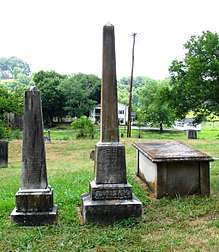Lebanon in the Forks Cemetery
The Lebanon in the Fork Cemetery, also known as Three Rivers Cemetery,[1] is a historic cemetery located at 2390 Asbury Road in eastern Knoxville, Tennessee, U.S..
Lebanon in the Forks Cemetery | |
 The Lebanon in the Forks Cemetery in 2010 | |
| Location | Knoxville, Tennessee |
|---|---|
| Coordinates | 35.9604172°N 83.8469586°W |
| NRHP reference No. | 10000934 |
| Added to NRHP | November 29, 2010 |
History

The Lebanon In The Fork Presbyterian Church was founded during 1791 by the Rev. Samuel Carrick.
Francis Alexander Ramsey, father of J. G. M. Ramsey, later donated nine acres of land overlooking the wide confluence of the Holston River with the French Broad River, where the "fork" and beginning of the Tennessee River is formed.
The first Lebanon In The Fork Presbyterian Church (no longer extant) at this site provided by Ramsey was constructed near the crest of the hill of rough hewn logs and measured approximately 40 feet by sixty feet.[2] This earlier structure was eventually replaced by a newer and larger building built in 1903. It served the church until it was burnt down by a fire in 1981. The bell was recovered and now sits in the cemetery. The church cemetery has been listed on the National Register of Historic Places since November 29, 2010.[3]
The Lebanon in the Fork Presbyterian Church pastors included Samuel Carrick,[4] Isaac L. Anderson,[5] J. G. M. Ramsey, and Richard Owen Currey.[6]
According to an account of a visit to Mecklenberg by "Ora," a correspondent of the Mobile Advertiser, (and later republished in within the April 6, 1862 edition of the Knoxville Register), the J.G.M Ramsey's Mecklenburg residence was located about 100 yards from "...the ruins of the old Presbyterian Church of Lebanon".[7]
The nearby historic Ramsey House (also known as "Swan Pond", the residence of Francis Alexander Ramsey and his family) offers guided tours of this residence that was built by Francis Alexander Ramsey. The Ramsey House also maintains the Lebanon In The Fork Presbyterian Church cemetery.
Location
The Lebanon In The Fork Presbyterian Church Cemetery is easily accessible from Interstate 640 in Knoxville:
head northeast on I-640 E to US-11E N/US-25W S/US-70 E;
use the left two lanes to merge onto I-40 E toward Asheville;
take exit 394 for US-11E/US-25W/US-70;
turn right onto TN-168 W;
turn right onto Strawberry Plains Pike;
turn left onto Thorngrove Pike, and;
follow Thorngrove Pike to either of the two entrances for Asbury Road.
References
- Buckles, Carol K.; Faulkner, Charles H., eds. (1978). Glimpses of Southern Appalachian Folk Culture: Papers in Memory of Norbert F. Riedl. Knoxville, Tennessee: Tennessee Anthropological Association. pp. 116–118. OCLC 4453939.
- http://knoxcotn.org/old_site/churches/lebanon/lebanon2.html "Lebanon "in the Fork" Presbyterian Church Founded 1791 by Rev. Samuel Carrick ~~ Knox County's first organized church ~~ ".
- "Lebanon in the Forks Cemetery". National Park Service. United States Department of the Interior. Retrieved November 3, 2017.
- "Church History". First Presbyterian Church. Retrieved November 4, 2017.
- J.G.M Ramsey, "History of Lebanon Presbyterian Church," 26 September 1876.
- Corgan, James X. (December 25, 2009). "Richard Owen Currey". The Tennessee Encyclopedia of History and Culture. Tennessee Historical Society and the University of Tennessee Press. Retrieved November 4, 2017.
- http://knoxcotn.org/old_site/history/mecklenburg.html "A Visit to Mecklenburg by "Ora".
External links

- Google Maps link https://goo.gl/maps/3NgqsA1k8Ey